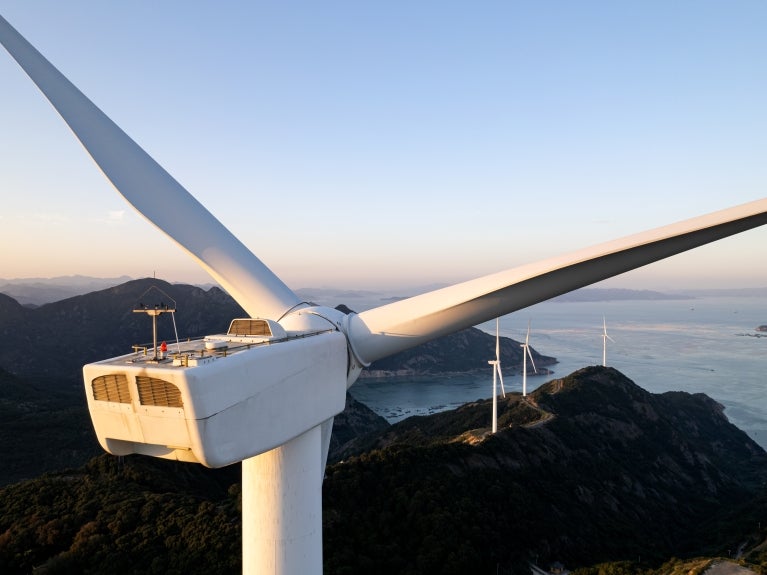An Active Quarter for Offshore Wind and Interregional Transmission Planning

The first quarter of 2023 saw a flurry of activity from state and federal agencies focused on offshore wind transmission. In early January, multiple states in New England jointly filed with the U.S. Department of Energy Grid Deployment Office (DOE-GDO) a concept paper (NE HVDC Concept Paper) for an innovative partnership to develop a meshed high-voltage direct current (HVDC) offshore wind transmission network, for which the states would like to receive funding under the Infrastructure Investment and Jobs Act (IIJA) (NE HVDC Concept Paper). In February, the DOE-GDO issued a draft of its National Transmission Needs Study (DOE-GDO Needs Study) that identifies multiple transmission needs in every region of the country and suggests these needs could be met through greater interregional transmission development, including needs in connection with integrating offshore wind projects. And on March 6, the New Jersey Board of Public Utilities (NJBPU) released its third solicitation for offshore wind proposals (Third Solicitation), for the first time mandating use of the Larrabee Tri-Collector (LCS) transmission solution, selected by the NJBPU last year, to interconnect winning bids. These activities demonstrate that the question of how best to connect the expected gigawatts (GW) of offshore wind being procured by states in these regions is front and center in the minds of regulators. But it remains to be seen whether the proposals on the table will lead to optimal cost-effective solutions or the kind of interregional transmission development described in the DOE-GDO Needs Study.
NE HVDC Concept Paper
On January 13, 2023, agencies from Connecticut, Maine, Massachusetts, and Rhode Island, with the support of New Hampshire and Vermont, submitted the NE HVDC Concept Paper for a proposed Joint State Innovation Partnership for Offshore Wind[1] to the DOE-GDO for consideration in the DOE-GDO's $5 billion Grid Innovation Program (GRIP).[2] The states outline a process to select an initial portfolio of one or more HVDC transmission lines and associated onshore system upgrades intended to "unlock the region's significant offshore wind potential, improve grid reliability and resilience, facilitate innovative regional cost allocation models, reduce innovative technology risk, and advance diversity, equity, and inclusion while investing in job growth and quality."[3] Noting that the New England offshore wind "leasehold"[4] can support up to 14 GW of offshore wind energy, but that the existing transmission system in New England lacks sufficient landfall points and infrastructure to support such magnitude of offshore injections, the New England states proposed an innovative vision for a multiterminal HVDC (MTDC) meshed backbone transmission network connecting the various offshore wind projects with multiple landing points across New England.[5] The proposal anticipates that this full MTDC backbone system would provide New England—"as well as, potentially, neighboring regions"[6]—significant grid reliability and resilience benefits. It also suggests that an MTDC backbone would be a more efficient way to meet state decarbonization goals compared to individual generator tie-lines.
The NE HVDC Concept Paper pushes the limits of current HVDC technology and standards. The proposal acknowledges that HVDC circuit breakers and other equipment necessary to build a full MTDC network do not yet exist and are not expected to be commercially available until 2025. Moreover, the paper recognizes that MTDC technical standards will need to be established for different developers' projects to connect to and function within the MTDC network. For those reasons, the NE HVDC Concept Paper proposes a "modular" approach that would see one to three HVDC transmission lines proposed initially, contingent on DOE-GDO funding. These would be built with intent to keep options open for a full MTDC network as technology and standards become available. This modular approach also allows "state off-ramps should there be a material change in circumstances"[7]—suggesting the drafters are well aware of the sometimes difficult history of New England states working together toward energy goals.
Still, the NE HVDC Concept Paper is one of the first state proposals to envision a fully HVDC offshore grid, as opposed to HVDC lines connecting an alternating current (AC) offshore network to shore. For example, in July 2022, the New York State Energy Research and Development Authority's (NYSERDA) request for offshore wind proposals required offered projects to be built "meshed ready" with individual HVDC cables connecting each project to shore, but equipped to connect in the future to a meshed network among projects using AC cable systems, based on existing technologies. NYSERDA received 100 total proposals for eight new projects from six offshore wind developers. NYSERDA anticipates awarding the contracts in the spring of 2022.
NJBPU Third Solicitation
The Third Solicitation seeks to procure between 1.2 and 4 GW of offshore wind capacity with estimated commercial operation dates in 2030. Submissions are due June 23, 2023, and a board decision is expected in December 2023. For the first time, NJBPU is requiring submissions to use the LCS as the point of interconnection for a project. The LCS is a transmission solution that was selected in a separate request for proposals (RFP) process that the NJBPU conducted last year and that, once built, will distribute up to 4,890 megawatts (MW) from the LCS to three existing points on the Pennsylvania-Jersey-Maryland (PJM) transmission system. To optimize use of this LCS capacity, the Third Solicitation requires each submission to include at least one project proposal that will utilize 1.2 GW of LCS capability.
In addition, for the first time, each proposal in the Third Solicitation must include a separate option for the construction of "Prebuild Infrastructure" including the duct banks and cable vaults needed to house transmission cables from a landfall point at the National Guard Training Center at Sea Girt, New Jersey to the LCS.[8] NJBPU intends to select a single developer to construct the Prebuild Infrastructure as well as its own offshore wind project, and all projects selected in the Third Solicitation will be required to use the Prebuild Infrastructure. This requirement would obligate one of the developers to shoulder the cost of all the necessary Prebuild Infrastructure, though the Third Solicitation left open the possibility that the NJBPU could fold the Prebuild Infrastructure into the LCS instead. If, however, one developer is selected to build the Prebuild Infrastructure, the structure could raise additional project-on-project risk concerns for developers whose projects are selected but who are not selected to build the Prebuild Infrastructure.
Finally, as NYSERDA did in its 2022 solicitation, the Third Solicitation requires developers to include design components necessary to all for the future possible development of a meshed offshore transmission network. While the Third Solicitation seeks to leave the door open for use of evolving HVDC technologies for such an offshore transmission network, the minimum requirements presume an AC offshore transmission network similar to the one envisioned by NYSERDA.
DOE-GDO Needs Study
The draft DOE-GDO Needs Study identifies multiple transmission needs—defined as the existence of present or expected electric transmission capacity constraints or congestion in a geographic area—across the country and notes a steady decline in transmission investment since 2015. While additional investment is needed in all regions across the country, according to the study, the Midwest and New England regions contributed the most eye-popping figures for what the study authors described as the most likely future scenario in light of recently enacted laws; the study reflects the need for new transmission deployment growth of 136% and 140% in those regions, respectively.
Many of the transmission needs identified in the study arise in connection with the effects of climate change and the need for increased resilience, including stresses to the grid from extreme heat and wildfires in the Southwest and Mountain regions, and stronger winter storms in the Southeast and Midwest regions. The DOE-GDO Needs Study concludes that "interregional transmission investments will help improve system resilience by enabling access to diverse generation resources across different climatic zones, which is becoming increasingly important as climate change drives more frequent extreme weather events that damage the power system."
The transmission needs identified in the DOE-GDO Needs Study also reflect continued evolution of the generation mix away from coal and natural gas toward higher concentrations of renewables. In part, the DOE-GDO Needs Study lends urgency to the efforts embodied in the NE HVDC Concept Paper, noting that the next set of generation procurements connecting to the Cape Cod area alone could face an additional $1.7 billion in onshore upgrades alone. The DOE-GDO Needs Study notes that the DOE's separate Atlantic Offshore Wind Transmission Study initiated in 2021 is still ongoing. While this is not mentioned in the DOE-GDO Needs Study, the DOE has also announced a new analysis studying West Coast offshore wind transmission options.[9]
The DOE-GDO Needs Study is intended to inform the implementation of the DOE's Loan Programs and its Transmission Infrastructure Program, future federal efforts such as the DOE's potential designation of National Interest Electric Transmission Corridors, and regional transmission planning. Comments on the draft Needs Study are due April 20, 2023, with the intent of issuing a final Needs Study by summer 2023.
Endnotes
[1] The Joint State Innovation Partnership for Offshore Wind is a collaborative effort between the New England states, transmission providers, and wind developers, working closely with the New England grid operator (ISO New England or ISO-NE). NE HVDC Concept Paper at 1.
[2] The DOE will select award winners for the GRIP solicitation in the fall of 2023.
[3] NE HVDC Concept Paper at 2.
[4] The paper states that the "New England leasehold includes one or more New York HVDC projects." NE HVDC Concept Paper at 7.
[5] The project location is the "BOEM Atlantic Wind Lease Offshore Massachusetts and substations to be determined along the New England coast." NE HVDC Concept Paper.
[6] NE HVDC Concept Paper at 4.
[7] NE HVDC Concept Paper at 3.
[8] NJ Third Solicitation at v & 4.
[9] DOE notes that the study "will evaluate multiple pathways to meet offshore wind goals, while supporting grid reliability and resilience and ocean co-use." The study will be led by Pacific Northwest National Laboratory and National Renewable Energy Laboratory, and will build on the West Coast Offshore Wind Transmission Literature and Gaps Analysis.
© 2023 Perkins Coie LLP
Print and share
Authors

Notice
Before proceeding, please note: If you are not a current client of Perkins Coie, please do not include any information in this e-mail that you or someone else considers to be of a confidential or secret nature. Perkins Coie has no duty to keep confidential any of the information you provide. Neither the transmission nor receipt of your information is considered a request for legal advice, securing or retaining a lawyer. An attorney-client relationship with Perkins Coie or any lawyer at Perkins Coie is not established until and unless Perkins Coie agrees to such a relationship as memorialized in a separate writing.

Notice
Before proceeding, please note: If you are not a current client of Perkins Coie, please do not include any information in this e-mail that you or someone else considers to be of a confidential or secret nature. Perkins Coie has no duty to keep confidential any of the information you provide. Neither the transmission nor receipt of your information is considered a request for legal advice, securing or retaining a lawyer. An attorney-client relationship with Perkins Coie or any lawyer at Perkins Coie is not established until and unless Perkins Coie agrees to such a relationship as memorialized in a separate writing.